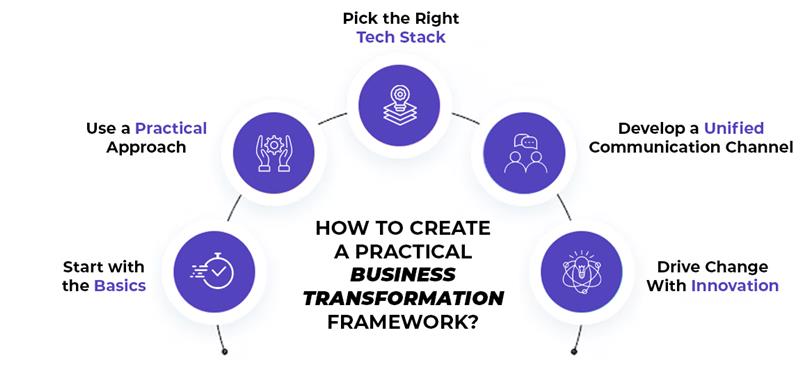If your organization isn’t adapting to changing markets and consumer trends, it’s about time you did. However, before you rush into your transformation odyssey, you need a modern business transformation framework to serve as a repeatable blueprint for your organizational success.
Let’s start by understanding the concept of business transformation.
What is Business Transformation?
A business transformation process typically involves making considerable changes to different aspects of a business, such as restructuring business strategies, technologies, methodologies, and company culture.
However, organizations that struggle with leadership, strategy development, execution, etc., and wish to pursue business transformation must streamline their journey by adhering to specific standards and procedures.
This is where a business transformation framework comes into play! In this blog, we’ll understand what it is, its key principles and benefits, and how to create a robust transformation framework.
Understanding Business Transformation Framework
A business transformation framework is a transformative methodology focusing on agility, adaptability, and continuous innovation. In other words, it uses an iterative approach that allows businesses to adapt and innovate in response to changing market and customer needs.
Consider a mid-market retail company seeking to enhance its online presence. The business owner can leverage the transformation framework by identifying the need to boost online sales, implementing an e-commerce platform that aligns with its operational capabilities, and establishing KPIs to monitor performance and customer satisfaction.
By using data-driven metrics and creating a culture of continuous improvement, the company can adapt its marketing initiatives based on real-time insights, ensuring that its technology investments lead to enhanced customer experiences and increased revenue.
Key Principles of a Business Transformation Framework
A reliable framework complies with the following principles, ensuring organizations are on the right path toward preparedness and growth.
Embracing agility and adaptation
Agility is the foremost principle that focuses on pivoting and adapting quickly to changing circumstances. Organizations adopt an iterative approach, breaking down transformation efforts into smaller or more manageable phases or cycles.
However, the framework requires regular reassessments of strategies. This makes it easier to address challenges, incorporate feedback, and respond to new developments. Such agility and iteration allow organizations to stay flexible rather than rigid, ensuring that the transformation process evolves whenever required.
Turning analytics into action
Business leaders love getting their hands on real-time, accurate data to make timely, informed decisions. This is why collecting, analyzing, and using the right data is stressed at every step of the transformation journey.
Instead of depending on assumptions or guesses based solely on gut instinct, decision-makers use data and insights from analytics to develop strategies, monitor progress, and adjust approaches.

Continuous innovation never stops
No major transformative initiative you’ll take for your business is a one-time work. However, continuous innovation and making situational amends along the journey are the keys to staying relevant.
Smart businesses eagerly seek constant experimentation, learn from outcomes, and always search for better ways to operate. Hence, the transformation framework tells us that the principle of continuous innovation is a core part of digitalization endeavors.
Built around customer needs
It might sound self-explanatory, but including a customer-centric approach as a core principle is important. This principle is actually a gentle reminder to business owners to deeply understand their customers’ preferences, behaviors, and pain points.
Your transformation efforts must align with customer expectations. Consider a mid-sized financial services company revamping its mobile app based on customer insights. It’ll introduce intuitive features like personalized financial planning tools and 24/7 chatbot support to align with customer expectations and enhance user experience.
Stronger through collaboration
The collaboration principle breaks down the silos across departments and teams, encouraging open communication and shared ownership of goals. The objective is to enable alignment and synergy across all levels of your company.
The collaborative ecosystem also emphasizes the importance of partnerships, both internally among teams and externally with stakeholders, vendors, and other businesses.
How Does the Framework Help Businesses?
Learn how a modern framework can guide your business and make you part of the digital transformation economy, which is expected to be worth $3.9 trillion by 2027.
Your blueprint for digital goals
A business transformation framework offers a clear and structured roadmap, acting as a strategic direction for organizations to achieve their digital goals. Besides that, you can also identify gaps or inefficiencies and determine actionable steps for improvement.
For example, a retail company might consider opening an ecommerce platform after prioritizing online sales. Hence, a sound framework will serve as a guided strategy focusing first on popular products and gradually scaling to the entire inventory.
Handpicked content: What’s Holding Back Your Digital Transformation Initiatives?
Focusing on what matters
The framework keeps your time, budget, and talent utilization on track. In other words, your resources are allocated effectively by prioritizing activities that support your overall digital strategy. Such resource allocation protects your people from wasting on low-impact projects and ensures they remain occupied with high-value activities.
A manufacturing company might prioritize automating its supply chain management system over upgrading its IT infrastructure as a part of its business transformation strategies. Given the fact that the former directly improves operational efficiency and cost savings.
Decisions backed by data
Driven by data and insights, leaders use structured frameworks to assess options and select the most feasible strategies for achieving their business transformation process goals.
Suppose a logistics company wants to analyze customer delivery data to identify bottlenecks and adopt real-time tracking systems. In that case, the framework will help improve operational efficiency and transparency in decision-making.

Scalable solutions for the future
A carefully designed framework accommodates your business growth and adapts to changing technologies, market trends, and customer behavior dynamics. The purpose is to establish that your transformation efforts remain relevant and aligned with your long-term goals.
For example, a SaaS company might adopt a modular framework to integrate new features into its tool as it expands its user base and into new regions.
Addressing risks before they arise
Leaders can use a systematic approach to identify potential risks and challenges early in the process of setting the business transformation roadmap. This work beforehand gives businesses ample time to prepare mitigation strategies.
Suppose a financial institution identifies cybersecurity as a potential risk to its digital transformation efforts. The service provider will likely invest in robust security protocols before launching its mobile banking app.
Putting customers first
The framework keeps the focus of your initiatives tied to your customers. In other words, the business transformation methodology encourages designing processes, products, and services that align with customer preferences.
If an online retailer wants to deliver personalized shopping experiences, it can use customer behavior data to recommend products based on the user’s browsing history.
How to Create a Practical Business Transformation Framework?
Although there is no standardized transformation framework applicable to all industries, I’ve covered the fundamental components here to help you get started.
Start with the basics
If you’re running a logistics company and aim to reduce delivery times by 20%, you might consider integrating a route optimization tool and streamlining batch processes. This brings us to the first step of developing a business transformation framework.
Start by writing a clear vision for your business, team, clients, and the industry. Focus on why digital transformation is essential for your organization in the first place—whether to improve operational efficiency, enhance customer experiences, or seek complete business model transformation.
Establish measurable goals to examine the success of your transformation efforts. The framework or methodology should support your organizational needs and business outcomes.
Craft a practical approach
Whether optimizing your existing efforts or considering a complete overhaul of your business model, your framework must be practical and adaptable. In short, a step-by-step implementation plan to achieve measurable outcomes throughout the transformation process.
For example, a healthcare provider might assess patient workflows and implement telemedicine services to facilitate remote consultations, prioritizing regions with limited physical access to onsite clinics.
Pick the right tech stack
You don’t want to pick the wrong tech stack and infrastructure irrelevant to your business and IT needs. Also, avoid the temptation to buy tools just because they’re new or trendy; instead, focus on technologies that fit your business strategy and address specific pain points. Ensure these tools enhance your workforce’s productivity, help in data-driven decision-making, and meet compliance and budget requirements.
Consider a retail chain adopting an AI-powered inventory management tool to predict stock demands. Investing in the application will help prevent overstocking and out-of-stock situations without affecting operational efficiency.

Handpicked content: Legacy vs. Modern: Transform Your Business with Application Modernization
Establish a unified communication channel
You must develop a clear communication channel across all levels of the organization—establishing a common language for transformation goals and building a culture of adaptability to change. Invest in training programs and regular updates to ensure all employees are on board and well-equipped to use new tools and processes effectively.
A financial services firm will consider rolling out a cloud-based CRM system and conducting workshops to train employees on the new tool and its features, ensuring smooth adoption across departments.
Drive change with innovation
We started our discussion by mentioning continuous innovation, an element without which a business transformation framework is incomplete. A manufacturing company integrating IoT sensors into machinery to monitor performance in real-time would be an example of continuous innovation and adaptability. The acquired data would be used to optimize maintenance schedules and prevent downtime.
Top of FormBottom of FormRegularly monitor market changes, business trends, and technology advancements. Moreover, periodically evaluate your transformation efforts to identify new opportunities and adjust strategies as needed.

Takeaways!
Your business transformation framework will most likely succeed when you comply with all the underlying principles and are prepared for your transformation journey.
By embracing agility, leveraging data-driven insights, prioritizing customer needs, and facilitating continuous innovation, organizations can proactively respond to changing markets and consumer expectations.
Whether enhancing operational efficiency, customer satisfaction, or scaling for growth, a well-thought-out framework ensures your actions are strategic, measurable, and impactful. Remember, transformation is not a one-off project but an ongoing commitment to evolving and thriving in your marketplace.
You can also collaborate with an experienced technology solutions provider to simplify your business growth through tailored solutions.
Read more: Top 5 Data Modernization Trends to Transform Your Business in 2025







